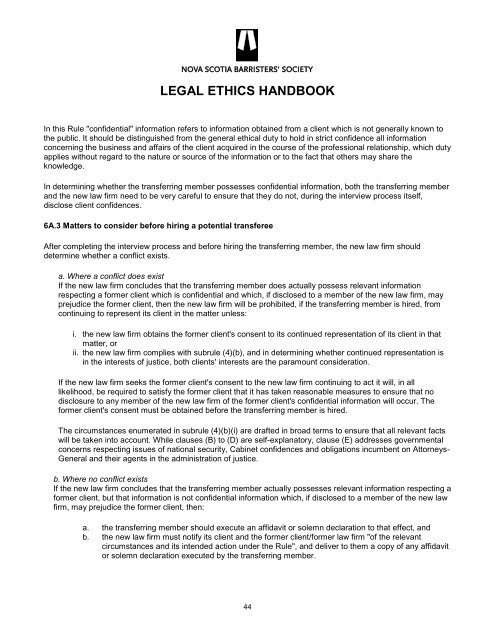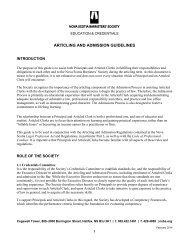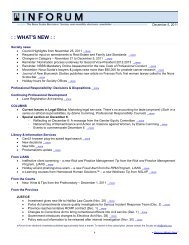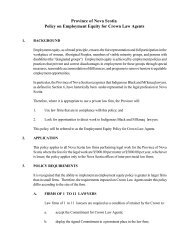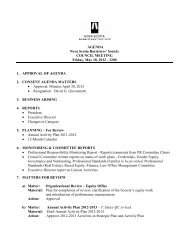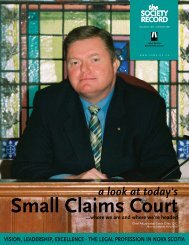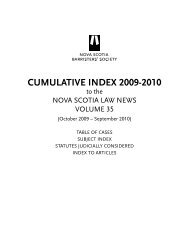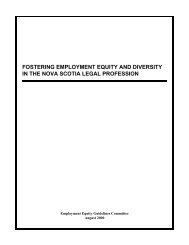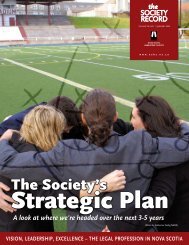legal ethics handbook - Nova Scotia Barristers' Society
legal ethics handbook - Nova Scotia Barristers' Society
legal ethics handbook - Nova Scotia Barristers' Society
Create successful ePaper yourself
Turn your PDF publications into a flip-book with our unique Google optimized e-Paper software.
LEGAL ETHICS HANDBOOK<br />
In this Rule "confidential" information refers to information obtained from a client which is not generally known to<br />
the public. It should be distinguished from the general ethical duty to hold in strict confidence all information<br />
concerning the business and affairs of the client acquired in the course of the professional relationship, which duty<br />
applies without regard to the nature or source of the information or to the fact that others may share the<br />
knowledge.<br />
In determining whether the transferring member possesses confidential information, both the transferring member<br />
and the new law firm need to be very careful to ensure that they do not, during the interview process itself,<br />
disclose client confidences.<br />
6A.3 Matters to consider before hiring a potential transferee<br />
After completing the interview process and before hiring the transferring member, the new law firm should<br />
determine whether a conflict exists.<br />
a. Where a conflict does exist<br />
If the new law firm concludes that the transferring member does actually possess relevant information<br />
respecting a former client which is confidential and which, if disclosed to a member of the new law firm, may<br />
prejudice the former client, then the new law firm will be prohibited, if the transferring member is hired, from<br />
continuing to represent its client in the matter unless:<br />
i. the new law firm obtains the former client's consent to its continued representation of its client in that<br />
matter, or<br />
ii. the new law firm complies with subrule (4)(b), and in determining whether continued representation is<br />
in the interests of justice, both clients' interests are the paramount consideration.<br />
If the new law firm seeks the former client's consent to the new law firm continuing to act it will, in all<br />
likelihood, be required to satisfy the former client that it has taken reasonable measures to ensure that no<br />
disclosure to any member of the new law firm of the former client's confidential information will occur. The<br />
former client's consent must be obtained before the transferring member is hired.<br />
The circumstances enumerated in subrule (4)(b)(i) are drafted in broad terms to ensure that all relevant facts<br />
will be taken into account. While clauses (B) to (D) are self-explanatory, clause (E) addresses governmental<br />
concerns respecting issues of national security, Cabinet confidences and obligations incumbent on Attorneys-<br />
General and their agents in the administration of justice.<br />
b. Where no conflict exists<br />
If the new law firm concludes that the transferring member actually possesses relevant information respecting a<br />
former client, but that information is not confidential information which, if disclosed to a member of the new law<br />
firm, may prejudice the former client, then:<br />
a. the transferring member should execute an affidavit or solemn declaration to that effect, and<br />
b. the new law firm must notify its client and the former client/former law firm "of the relevant<br />
circumstances and its intended action under the Rule", and deliver to them a copy of any affidavit<br />
or solemn declaration executed by the transferring member.<br />
44


